小升初高频考点剖析:第二篇专项提升第三部分第二节疑问句 课件(68张PPT)
文档属性
| 名称 | 小升初高频考点剖析:第二篇专项提升第三部分第二节疑问句 课件(68张PPT) | 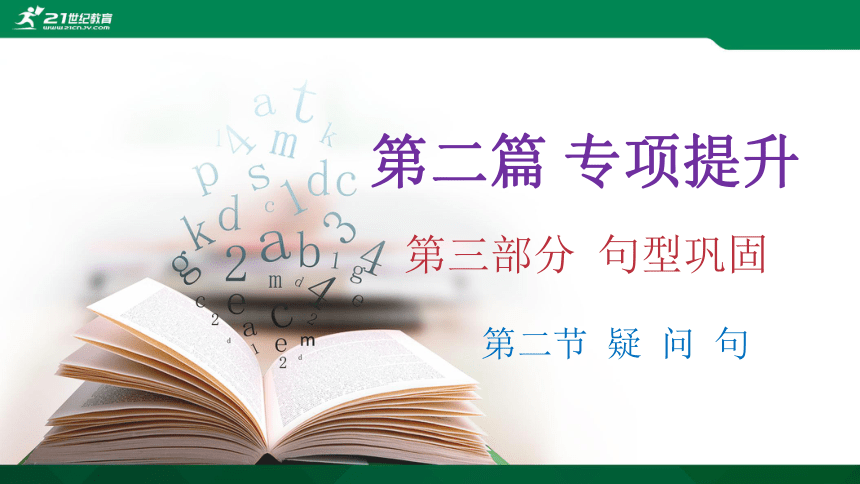 | |
| 格式 | zip | ||
| 文件大小 | 1.2MB | ||
| 资源类型 | 试卷 | ||
| 版本资源 | 通用版 | ||
| 科目 | 英语 | ||
| 更新时间 | 2020-07-03 11:31:15 | ||
图片预览

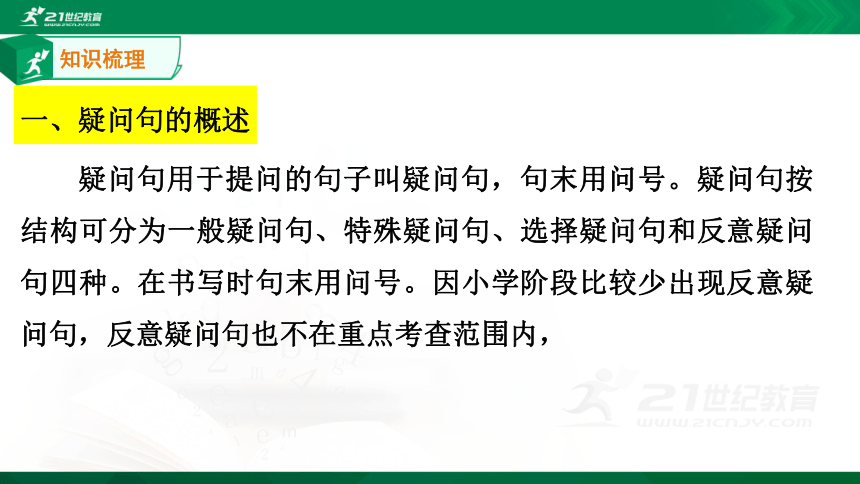
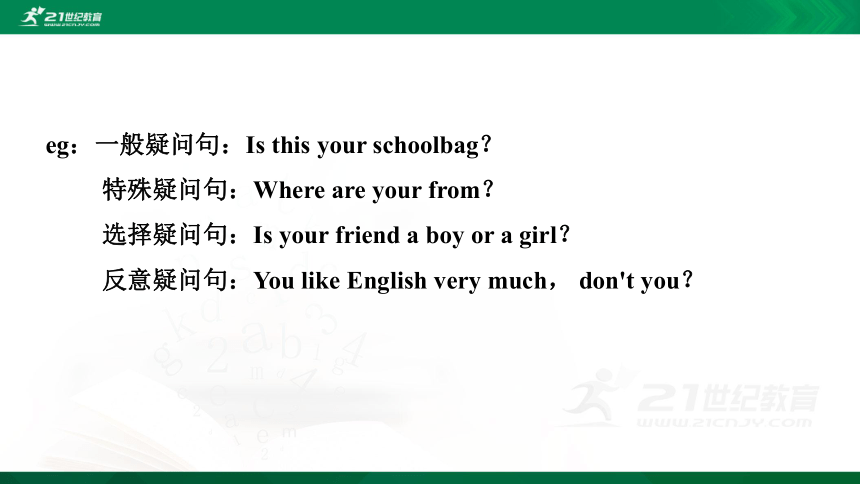
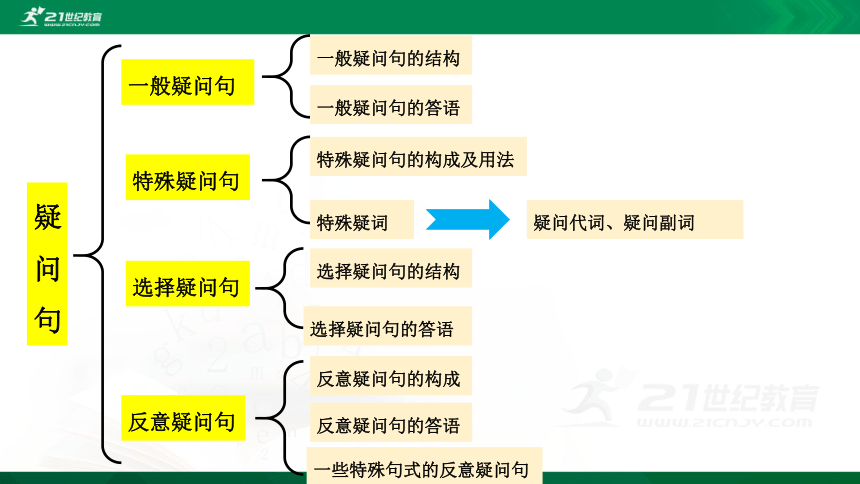

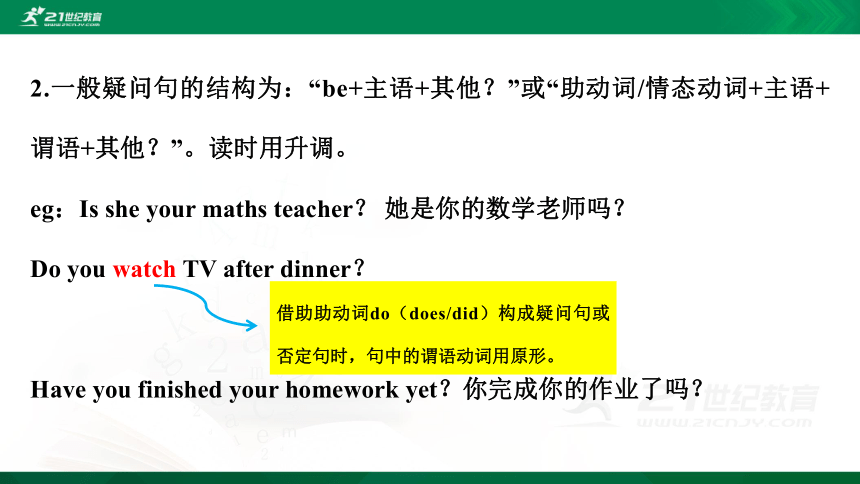
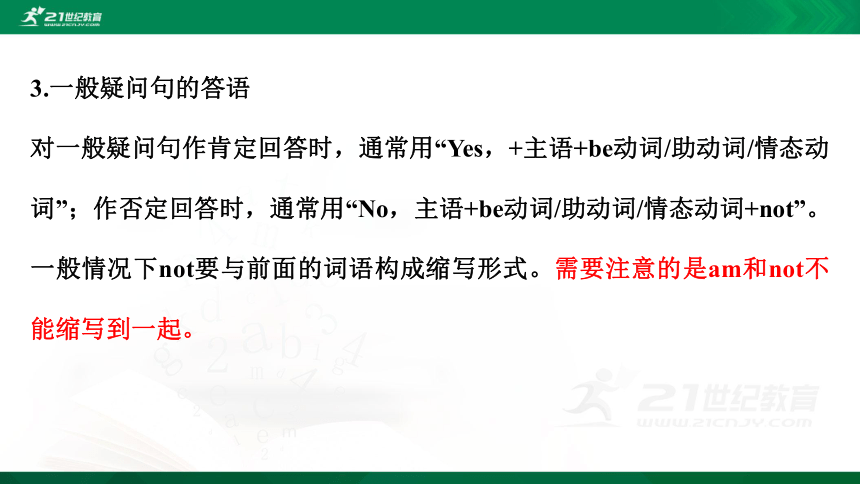
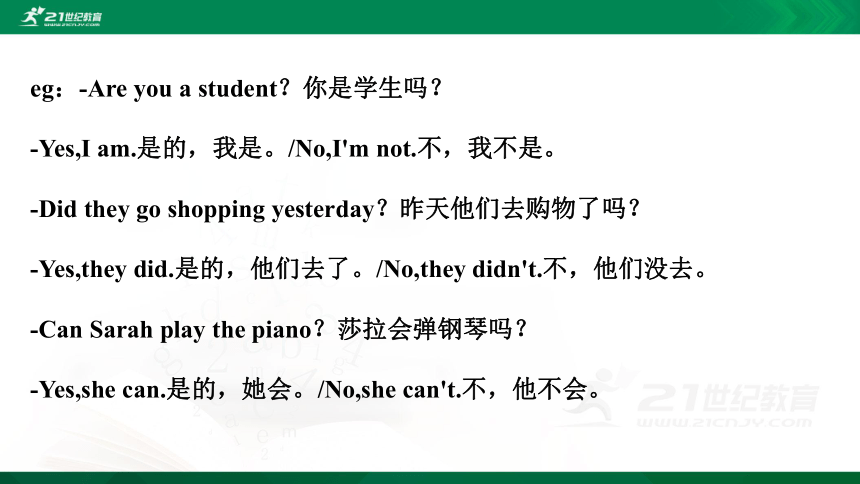
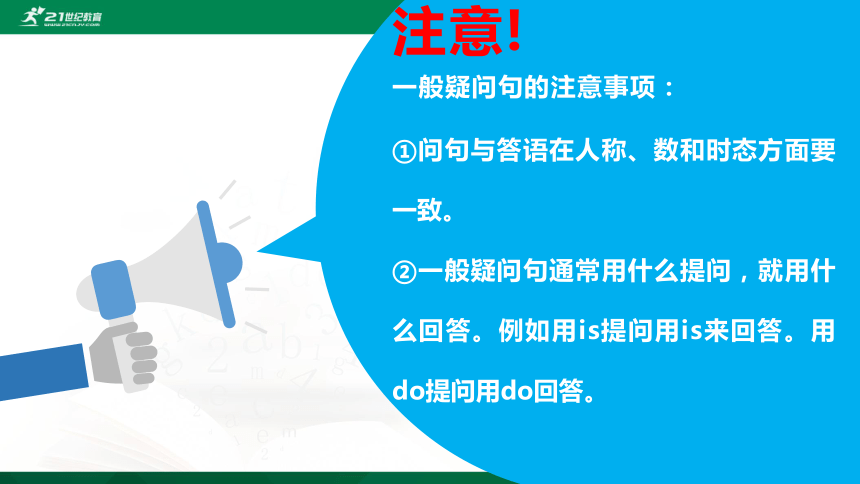
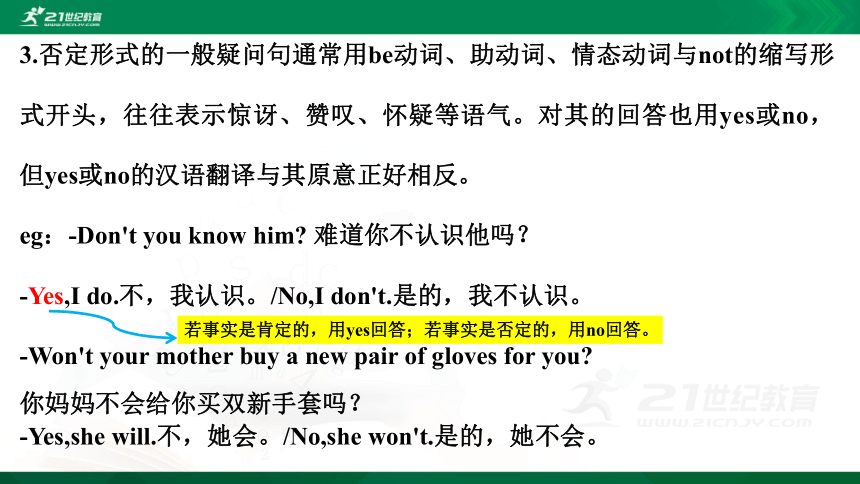
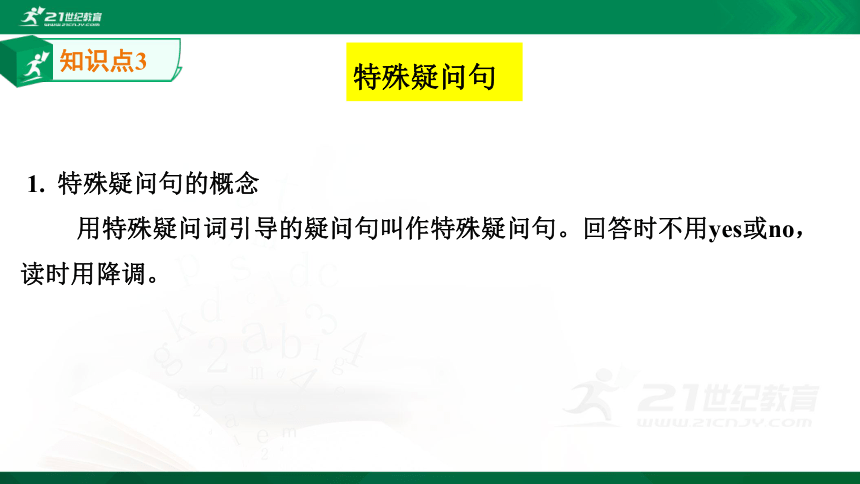
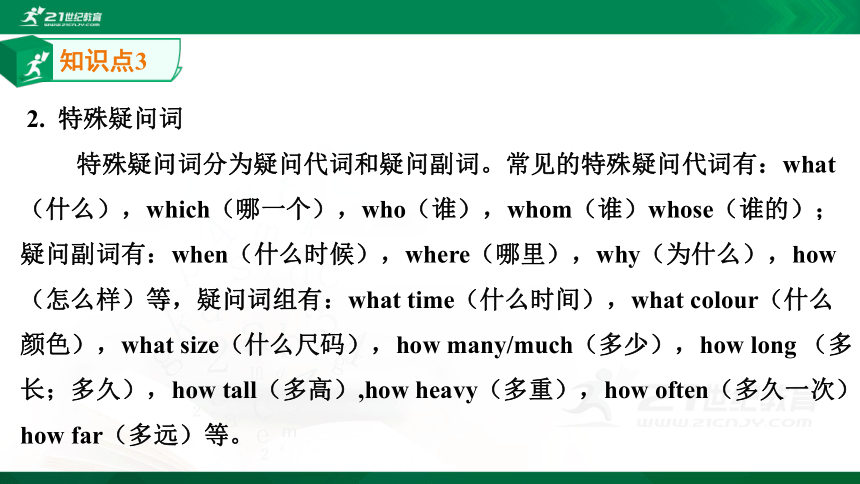
文档简介
(共68张PPT)
第二篇
专项提升
第三部分
句型巩固
第二节
疑
问
句
知识梳理
疑问句用于提问的句子叫疑问句,句末用问号。疑问句按结构可分为一般疑问句、特殊疑问句、选择疑问句和反意疑问句四种。在书写时句末用问号。因小学阶段比较少出现反意疑问句,反意疑问句也不在重点考查范围内,
一、疑问句的概述
eg:一般疑问句:Is
this
your
schoolbag?
特殊疑问句:Where
are
your
from?
选择疑问句:Is
your
friend
a
boy
or
a
girl?
反意疑问句:You
like
English
very
much,
don't
you?
疑问句
特殊疑问句
一般疑问句
选择疑问句
反意疑问句
一般疑问句的结构
一般疑问句的答语
特殊疑问句的构成及用法
特殊疑词
疑问代词、疑问副词
选择疑问句的结构
选择疑问句的答语
反意疑问句的构成
反意疑问句的答语
一些特殊句式的反意疑问句
1.一般疑问句的概念
一般疑问句通常用来询问一件事情是否属实,答句通常由“yes”或“no”引导,所以一般疑问句又称作“是非问句”,即“Yes/No
questions”。朗读一般疑问句时用升调,而一般疑问句的简略答语则用降调。
知识点2
一般疑问句
2.一般疑问句的结构为:“be+主语+其他?”或“助动词/情态动词+主语+谓语+其他?”。读时用升调。
eg:Is
she
your
maths
teacher?
她是你的数学老师吗?
Do
you
watch
TV
after
dinner?
Have
you
finished
your
homework
yet?你完成你的作业了吗?
借助助动词do(does/did)构成疑问句或否定句时,句中的谓语动词用原形。
3.一般疑问句的答语
对一般疑问句作肯定回答时,通常用“Yes,+主语+be动词/助动词/情态动词”;作否定回答时,通常用“No,主语+be动词/助动词/情态动词+not”。一般情况下not要与前面的词语构成缩写形式。需要注意的是am和not不能缩写到一起。
eg:-Are
you
a
student?你是学生吗?
-Yes,I
am.是的,我是。/No,I'm
not.不,我不是。
-Did
they
go
shopping
yesterday?昨天他们去购物了吗?
-Yes,they
did.是的,他们去了。/No,they
didn't.不,他们没去。
-Can
Sarah
play
the
piano?莎拉会弹钢琴吗?
-Yes,she
can.是的,她会。/No,she
can't.不,他不会。
注意!
一般疑问句的注意事项:
①问句与答语在人称、数和时态方面要一致。
②一般疑问句通常用什么提问,就用什么回答。例如用is提问用is来回答。用do提问用do回答。
3.否定形式的一般疑问句通常用be动词、助动词、情态动词与not的缩写形式开头,往往表示惊讶、赞叹、怀疑等语气。对其的回答也用yes或no,但yes或no的汉语翻译与其原意正好相反。
eg:-Don't
you
know
him?
难道你不认识他吗?
-Yes,I
do.不,我认识。/No,I
don't.是的,我不认识。
-Won't
your
mother
buy
a
new
pair
of
gloves
for
you?
你妈妈不会给你买双新手套吗?
-Yes,she
will.不,她会。/No,she
won't.是的,她不会。
若事实是肯定的,用yes回答;若事实是否定的,用no回答。
1.
特殊疑问句的概念
用特殊疑问词引导的疑问句叫作特殊疑问句。回答时不用yes或no,读时用降调。
知识点3
特殊疑问句
2.
特殊疑问词
特殊疑问词分为疑问代词和疑问副词。常见的特殊疑问代词有:what(什么),which(哪一个),who(谁),whom(谁)whose(谁的);疑问副词有:when(什么时候),where(哪里),why(为什么),how(怎么样)等,疑问词组有:what
time(什么时间),what
colour(什么颜色),what
size(什么尺码),how
many/much(多少),how
long
(多长;多久),how
tall(多高),how
heavy(多重),how
often(多久一次)how
far(多远)等。
知识点3
3.特殊疑问句的构成
(1)特殊疑问词+be+主语+表语+其他?
eg:Why
are
you
late
for
school?
你为什么上学迟到?
How
old
are
you?
你多大了?
(2)特殊疑问词+助动词/情态动词+主语+谓语+其他?
eg:How
often
do
you
visit
your
grandfather?
你多久去看望一次你的爷爷?
How
long
have
you
stayed
in
Beijing?
你在北京待了多久?
4.特殊疑问句的答语
回答特殊疑问句时,不用yes或no,而是问什么答什么,尤其是简略的答语。
eg:-Who
is
from
China?谁来自中国?-Wu
Yifan(is).吴亦凡。
-Why
do
you
like
winter?你为什么喜欢冬天?
-Because
I
can
make
a
snowman.因为我能堆雪人。
-What
time
is
it?几点了?-It's
7:00.
七点了。
5.否定形式的特殊疑问句一般有劝告、建议、责备等意思。
eg:Why
don't
you
go
bike
riding
with
me?
为什么不和我一起去骑自行车兜风?
6.
常见的特殊疑问词(组)及其用法
(1)what:用于对指物的名词或动词短语提问。
eg:This
is
an
apple.→What
is
this?
I
am
going
to
play
basketball.→What
are
you
going
to
do?
(2)
when:用于对时间提问。
eg:I
clean
my
room
in
the
morning.→When
do
you
clean
your
room?
John
went
to
the
cinema
at
8:00
last
night.→When
did
John
go
to
the
cinema
last
night?
(3)where:用于对地点提问。
eg:
I
am
from
China.→Where
are
you
from?
(4)why:用于对事情的原因提问。
eg:I
go
to
work
by
subway
because
it
is
fast.→Why
do
you
go
to
work
by
subway?
(5)how:用于对方式或程度等提问。
eg:I
go
to
school
on
foot.→How
do
you
go
to
school?
(6)which:用于对名词前的修饰词提问,而且必须和名词连用。
eg:
I
want
the
big
backpack.→Which
backpack
do
you
want?
The
woman
with
a
handbag
is
Miss
Green.→Which
woman
is
Miss
Green?
The
taller
man
is
Mr
Black.→Which
man
is
Mr
Black?
(7)who:用于对人提问,作宾语时可用whom代替。
eg:
My
sister
is
drawing
a
horse.→Who
is
drawing
a
horse?
I
often
play
with
Lucy
after
school.→Who/Whom
do
you
often
play
with
after
school?
【注】用who对主语提问时,后面的谓语动词或助动词一般要用第三人称单数形式。
(8)
whose:用于对物主代词和名词所有格提问,通常和名词连用。
eg:Mike's
coat
is
on
the
chair.→Whose
coat
is
on
the
chair?
(9)
what
time:用于对时刻提问。
eg:
It's
6:40
now.→What
time
is
it
now?
(10)what
colour:用于对颜色提问。
eg:The
curtain
is
yellow.→
What
colour
is
the
curtain?
(11)
how
many:用于对可数名词的数量提问。
eg:I
see
two
hundred
rabbits
on
the
farm.→How
many
rabbits
do
you
see
on
the
farm?
There
is
one
duck
in
the
river.→How
many
ducks
are
there
in
the
river?
【注】how
many必须接名词的复数形式。
(12)
how
much:用于对价格提问,以及对不可数名词的数量提问。
eg:The
pen
is
12
yuan.→How
much
is
the
pen?
I
bought
2
bottles
of
juice.→How
much
juice
did
you
buy?
(13)how
long:用于对长度或动作在时间上所持续的长度提问;how
tall:用于对高度提问;how
heavy:用于对重量提问。
eg:The
ruler
is
2
metres
long.→How
long
is
the
ruler?
I
stay
in
Shanghai
for
three
days.→How
long
do
you
stay
in
Shanghai?
Mike
is
158
cm
tall.→How
tall
is
Mike?
I'm
51
kg.→How
heavy
are
you?
(14)how
often:用于对时间频率提问。
eg:
I
water
the
flowers
once
a
day.→How
often
do
you
water
the
flowers?
(15)how
far:用于对距离提问。
eg:It's
about
two
kilometres
from
here
to
the
country.→How
far
is
it
from
here
to
the
country?
(16)对日期、星期几、天气等提问,则分别用:
问日期:What's
the
date
today?
问星期几:What
day
is
it
today?
问天气:What's
the
weather
like
today?=How's
the
weather
today?
1.选择疑问句的概念
选择疑问句是指提出两个或两个以上可能的答案供对方选择的句式。,前一部分是一般疑问句或特殊疑问句,后面加上or提供给对方另一个条件。来让对方根据实际情况进行选择问答。语调一般前升后降,如果有两个以上供选择的答案,则在最后一个用降调,其余都用升调。
知识点4
选择疑问句
2.选择疑问句的构成
选择疑问句是指提出两个或两个以上可能的答案供对方选择的句式。,前一部分是一般疑问句或特殊疑问句,后面加上or提供给对方另一个条件。来让对方根据实际情况进行选择问答。语调一般前升后降,如果有两个以上供选择的答案,则在最后一个用降调,其余都用升调。
(1)一般选择疑问句:一般疑问句+or+被选择部分?
eg:Would
you
like
watermelons
or
pears?
你想要西瓜还是梨?
Do
you
like
pink
or
red?
你喜欢粉色还是红色?
(2)特殊选择疑问句:特殊疑问句+A
or
B?
eg:Which
sweater
do
you
like
better,the
pink
one
or
the
blue
one?
你比较喜欢哪件毛衣,粉色的还是蓝色的?
3.选择疑问句的答语
选择疑问句不能用yes或no来回答,而必须选择其中一项进行回答,或者将选项全部否定。
eg:-Can
you
sing
or
dance?你会唱歌还是会跳舞?
-I
can
dance.
我会跳舞。
-Is
she
a
teacher
or
a
driver?她是个老师还是个司机?
-Neither.She
is
a
nurse.
都不是,她是个护士。
注意!
选择疑问句中,or
后的不定冠词a/an
不能省略。
1.反意疑问句的概念
在陈述句后附上一个简短的问句(又称附加问句),对陈述句所述的内容提出相反的疑问,这种疑问句叫反意疑问句。读时陈述句部分用降调,附加问句部分用升调。如果陈述部分是肯定形式,附加问句部分就用否定形式;如果陈述部分是否定形式,则附加句部分用肯定形式。即可以简记为“前肯后否,前否后肯”。
知识点5
反意疑问句
2.反意疑问句的构成
(1)
陈述句+否定附加问句?
eg:You
are
a
student,aren't
you?
你是个学生,不是吗?
Tom
likes
playing
basketball,doesn't
he?
汤姆喜欢打篮球,不是吗?
Mary
came
early,didn't
she?
玛丽来得很早,不是吗?
附加问句部分用she代替上文的Mary;两部分都为一般过去时态。
注意!
附加问句的主语必须是代词,并且应与陈述句部分的主语一致;谓语动词在人称、数和时态方面也要与陈述部分一致。
(2)否定陈述句+肯定附加问句?
eg:Lucy
can't
speak
English,can
she?
露西不会说英语,是吗?
He
doesn't
like
maths,does
he?
他不喜欢数学,是吗?
注意!
(1)陈述部分如果有never,seldom,hardly,little,few,no,no
one,,nobody,none,nothing
等表示否定意义的词或词组时,附加问句必须用肯定形式。
eg:He
can
hardly
swim,can
he?
他几乎不会游泳,是吗?
She
said
nothing,did
she?
她什么也没说,是吗?
注意!
(2)若陈述部分含有答否定前缀un-,dis-,im-等,或者否定后缀-less的词,如unhappy,dislike,unfriendly,将它看作肯定句,附加问句仍用否定形式。
eg:He
look
unhappy,doesn't
he?
他看上去不高兴,不是吗?
It
is
impossible,isn't?
这不可能,不是吗?
3.反意疑问句的答语
反意疑问句的回答,无人问题的提法如何,如果事实是肯定的,就用yes,后跟肯定形式的简略答语;如果是事实否定的,就要用no,后跟否定形式的简略答语。但要注意当陈述部分是否定句时,答语中的yes要译成“不”,no要译成“是”。
eg:-He
likes
playing
the
piano,doesn't
he?
他喜欢弹钢琴,不是吗?
-Yes,he
does.是的,他喜欢。/No,he
doesn't。不,他不喜欢。
-His
brother
didn't
attend
the
meeting,did
he?
他的弟弟没有参加会议,不是吗?
-Yes,he
did.不,他参加了。/No,he
didn't.
是的,他没有参加。
拓展:反意疑问句口诀
反意疑问句并不难,陈述疑问句中含;
前后肯否恰相反,否定词缀不能算;
主谓时态要一致,特殊情况记心田;
实际情况来回答,再把yes和no拣。
4.反意疑问句的用法
(1)当陈述部分的主语是表示事物的不定代词,如nothing,something,anything,everything等时,附加问句的主语用it。
eg:Everything
is
ready,isn't
it?一切都准备好了,是吗?
Nothing
is
impossible,is
it?没有什么是不可能的,不是吗?
(2)当陈述部分的主语是表示人的不定代词,如somebody,someone,no
one,nobody,everybody等时,附加问句的主语用he或they。
eg:Nobody
was
late
,were
they?
没有人迟到,是吗?
(3)当陈述部分的主语位指示代词this,that时,附加问句的主语用it;当陈述部分的主语位指示代词these,those时,附加问句的主语用they。
eg:This
is
a
beautiful
picture,isn't
it?
这是一幅美丽的图画,不是吗?
These
are
useful
book,aren't
they?
这些是有用的书,不是吗?
(4)陈述部分是there
be结构时,附加问句部分用be
there。
eg:There
was
nothing
in
the
room,was
there?
房间里什么也没有,是吗?
There
are
some
bananas
on
the
table,aren't
there?
桌子上有一些香蕉,不是吗?
(5)当陈述部分为祈使句的肯定形式时,附加问句可用will
you
或won't
you;是祈使句的否定形式时,附加问句用will
you。但是以let's开头的祈使句,附加问句一般用shall
we;而以let
us开头的祈使句,附加问句用will
you。
eg:Listen
to
me
carefully,will/won't
you?仔细听我说,好吗?
Don't
run
in
the
hallway,will
you?不要在走廊里跑,好吗?
Let's
go
and
listen
to
music,shall
we?我们去听音乐,好吗?
Let
us
wait
for
you
in
the
reading
room,will
you?
让我们在阅览室等你,好吗?
(6)当陈述部分为主从复合句时,若主语为第一人称,且谓语部分为think,believe,imagine,expect等时,附加问句的主语应与从句的主语保持一致;若主句的主语为第一、二、三人称时,附加问句的主语应与主句的主语一致,此时,否定只看主句,与从句无关。
eg:I
expect
our
English
theater
will
be
back
this
weekend,won't
she?
I
don't
think
he
will
come,will
he?
附加问句与从句保持一致。
注意否定的转移,当宾语从句的否定转移到主语时,其仍属于否定,其后的附加问句应用肯定形式。
eg:He
knows
where
I
live,doesn't
he?
They
don't
believe
she
is
an
engineer,do
they?
附加问句的主语与主句的主语保持一致。
(7)陈述部分有动词have(has/had)时的反意疑问句。
①当have(has/had)为构成完成时的助动词时,附加问句的谓语动词用助动词have(has/had)。
eg:Lucy
has
gone
to
Beijing,hasn't
she?
②当have(has/had)为实义动词时,常表示“拥有”或“吃、喝、玩、度过”的意思,此时附加问句的谓语动词用助动词do(does/did)。
eg:Tom
has
a
brother,doesn't
he?汤姆有个哥哥,不是吗?
They
had
a
good
time
yesterday,didn't
they?
他们昨天玩得很开心,不是吗?
③have(has/had)to表示“不得不,必须”之意时,附加问句的谓语动词用助动词do(does/did)。
eg:Kate
has
to
look
after
her
sister,doesn't
she?
凯特必须照顾她的妹妹,不是吗?
(8)当陈述部分的谓语是used
to
时,附加问句部分用“didn't+主语”或是“usedn't+主语”。
eg:He
used
to
take
pictures
there,didn't/usedn't
he?
他过去常在那里拍照,不是吗?
(9)当陈述部分是感叹句时,附加问句只能用否
定形式。
eg:What
a
nice
day,isn't
it?天气多好呀,不是吗?
What
a
clever
boy,isn't
it?多么聪明的一个男孩子呀,不是吗?
(10)当陈述部分为“had
better+动词原形”时,附加问句部分用hadn't。
eg:You'd
better
read
it
by
yourself,hadn't
you?
你最好自己读,不是吗?
He'd
better
leave
here,hadn't
he?他最好离开这里,是吗?
(11)当陈述部分是I'm...时,附加问句通常用aren't
I。
eg:I'm
older
than
you,aren't
I?
我年纪比你大,对不对?
知识点6
考点精析
考查特殊疑问词的理解运用
考点
【例1】Listen
and
choose.
听问句,选择最合适的应答句,并将其字母编号填在括号内。
(
)1.
A.
It
is
white.
B.
It
is
a
white.
(
)2.
A.
It's
about
20
cm
long.
B.
It's
about
2.1
m
tall.
听力材料:1.
What
colour
is
the
bed?
2.
How
long
is
the
ruler?
解析:本题考查特殊疑问词组所构成的特殊疑问句。这要求学生熟记各疑问词组的意思和用法,
同时根据问句分析,选择正确答句是关键。第1小题问句中的What
colour涉及颜色;
第2小题问句中的How
long与长度相关。
答案:1.
2.
A
A
考查疑问句在情景交际中的运用
考点2
【例2】Ask
and
Answer.
根据答句写问句,使对话合理、通顺。
1.
A:Chen
Jie,
there
is
a
dress
over
there.________________________
B:Maybe
it's
Sarah's.
Her
dress
is
pink.
2.
A:There
was
an
NBA
basketball
game
on
TV
last
night.
__________
B:No,
I
had
much
homework
to
do.
解析:这类题主要考查根据答句写出问句的能力,要求学生读懂答句的句意和语境,写出符合语境的问句。第1题答句中的Sarah's是物主代词,故应用whose提问。第2题答句用no回答,所以问题是一般疑问句。
答案:1.
2.
Whose
coat
is
it?
Did
you
watch
it?
一、Read
and
fill.
用适当的特殊疑问词组填空。
1.
A:___________
is
your
desk?
B:Yellow.
2.
A:
__________
do
you
go
shopping
on
the
weekend?
B:At
10:00
a.
m.
3.
A:
__________
do
you
wear?
B:I
wear
Size
L.
4.
A:
__________
is
it
today?
B:
It's
Monday.
What
colour
What
time
举一反三
What
size
What
day
二、Read
and
fill.
用适当的特殊疑问词填空。
1.
A:__________
coat
is
that?
B:It's
mine.
2.
A:__________
is
the
teachers'
office?
B:It's
on
the
second
floor.
3.
A:__________
do
you
like
this
dress?
B:It's
pretty.
4.
A:__________
season
do
you
like
best?
B:Winter.
Whose
Where
How
Which
三、Read
and
write.
就画线部分提问。
1.
I
can
play
the
piano.
___________________________________________________________
2.
There
are
50
students
in
my
classroom.
___________________________________________________________
3.
This
brown
coat
is
mine.
___________________________________________________________
What
can
you
do?
How
many
students
aretherein
your
classroom?
Whose
coat
is
this?
1.Sam:Mum,
_______________________________
Mum:It's
cold.
So
you
can't
go
outside.
2.A:
_________________________________
B:I
often
do
my
homework
on
the
weekend.
3.Tom:I
want
to
play
basketball.
Where
is
my
ball?
__________________
Mum:Yes,it
is.
Is
it
in
my
toy
box?
四、Ask
and
answer.
根据答句写问句,使对话合理、通顺。
1.
what's
the
weather
like
today?
2.
What
do
you
do
on
the
weekend?
3.
(
)1.
Sam:__________
shirt
is
it?
Tom:It's
Jack's.
A.
Who
B.
What
colour
C.
Whose
(
)2.
Sarah:__________
is
my
dog?
Amy:It's
on
the
desk.
A.
Where
B.
What
C.
Whose
(
)3.
John:__________
season
do
you
like
best?
Lily:Winter.
A.
What
B.
Which
C.
Whose
一、Read
and
choose.
单项填空。
过关检测
C
A
B
(
)4.
__________
you
like
some
water?
A.
Are
B.
Can
C.
Would
(
)5.
Zip:__________
isthis
dress?
Zoom:It's
190
yuan.
A.
How
many
B.
How
much
C.
How
far
(
)6.
Chen
Jie:__________
sheep
do
you
see?
Lucy:60.
A.
How
many
B.
How
much
C.
How
far
(
)7.
Will
she
__________
tomorrow?
A.
come
B.
comes
C.
coming
C
B
A
A
(
)8.
__________
you
__________
shopping
this
Saturday?
A.
Will;
go
to
B.
Will;
go
C.
Will;
going
(
)9.
Jane:__________?
Mike:It's
Sunday.
A.
What
day
is
it
B.
What
time
is
it
C.
When
is
it
(
)10.
How
many
__________
can
you
have?
A.
car
B.
cars
C.
cares
B
A
B
二、Read
and
fill.
用适当的特殊疑问词(组)填空。
1.
A:__________
dress
is
on
the
bed?
B:Sarah's.
2.
A:__________
map
is
Sarah's?
B:The
one
on
the
bed.
3.
A:__________
is
Sarah's
dress?
B:On
the
bed.
4.
A:____________
is
the
dress?
B:Pink.
5.
A:____________
is
the
dress?
B:It's
$180
.
Whose
Which
Where
What
colour
How
much
6.
A:__________
are
you?
B:I
am
16
years
old.
7.
A:__________
are
you?
B:I
am
1.65
metres.
8.
A:__________
girl
is
Sarah?
B:The
girl
in
pink.
9.
A:__________
is
this
man?
B:He
is
my
faher.
10.
A:__________
do
you
do
morning
exercises?
B:Twice
a
week.
How
old
How
tall
Which
Who
How
often
三、Read
and
write.
将下列陈述句改为一般疑问句。
1.
Fido
is
sleeping.
_________________________________________________________
2.
She
leaves
home
very
early.
_________________________________________________________
3.
My
sister
often
does
her
homework
at
home.
_________________________________________________________
Is
Fido
sleeping?
Does
she
leave
home
very
early?
Does
your
sister
often
do
her
homework
at
home?
4.
He
is
two
years
older
than
his
sister.
_________________________________________________________
5.
Tom
has
lunch
at
school
every
day.
_________________________________________________________
6.
I
did
my
homework
at
school
yesterday.
_________________________________________________________
Is
he
two
years
older
than
his
sister?
Does
Tom
have
lunch
at
school
every
day?
Did
you
do
your
homework
at
school
yesterday?
四、Read
and
write.
就画线部分提问。
1.
I
am
going
to
see
a
film
tomorrow.
__________________________________________________________
2.
I
am
going
to
visit
my
grandfather
this
week.
__________________________________________________________
3.
She
writes
to
her
parents
once
a
week.
__________________________________________________________
What
are
you
going
to
do
tomorrow?
When
am
going
to
visit
my
grandfather?
How
often
does
she
write
to
her
parents?
谢谢
21世纪教育网(www.21cnjy.com)
中小学教育资源网站
有大把高质量资料?一线教师?一线教研员?
欢迎加入21世纪教育网教师合作团队!!月薪过万不是梦!!
详情请看:
https://www.21cnjy.com/help/help_extract.php
第二篇
专项提升
第三部分
句型巩固
第二节
疑
问
句
知识梳理
疑问句用于提问的句子叫疑问句,句末用问号。疑问句按结构可分为一般疑问句、特殊疑问句、选择疑问句和反意疑问句四种。在书写时句末用问号。因小学阶段比较少出现反意疑问句,反意疑问句也不在重点考查范围内,
一、疑问句的概述
eg:一般疑问句:Is
this
your
schoolbag?
特殊疑问句:Where
are
your
from?
选择疑问句:Is
your
friend
a
boy
or
a
girl?
反意疑问句:You
like
English
very
much,
don't
you?
疑问句
特殊疑问句
一般疑问句
选择疑问句
反意疑问句
一般疑问句的结构
一般疑问句的答语
特殊疑问句的构成及用法
特殊疑词
疑问代词、疑问副词
选择疑问句的结构
选择疑问句的答语
反意疑问句的构成
反意疑问句的答语
一些特殊句式的反意疑问句
1.一般疑问句的概念
一般疑问句通常用来询问一件事情是否属实,答句通常由“yes”或“no”引导,所以一般疑问句又称作“是非问句”,即“Yes/No
questions”。朗读一般疑问句时用升调,而一般疑问句的简略答语则用降调。
知识点2
一般疑问句
2.一般疑问句的结构为:“be+主语+其他?”或“助动词/情态动词+主语+谓语+其他?”。读时用升调。
eg:Is
she
your
maths
teacher?
她是你的数学老师吗?
Do
you
watch
TV
after
dinner?
Have
you
finished
your
homework
yet?你完成你的作业了吗?
借助助动词do(does/did)构成疑问句或否定句时,句中的谓语动词用原形。
3.一般疑问句的答语
对一般疑问句作肯定回答时,通常用“Yes,+主语+be动词/助动词/情态动词”;作否定回答时,通常用“No,主语+be动词/助动词/情态动词+not”。一般情况下not要与前面的词语构成缩写形式。需要注意的是am和not不能缩写到一起。
eg:-Are
you
a
student?你是学生吗?
-Yes,I
am.是的,我是。/No,I'm
not.不,我不是。
-Did
they
go
shopping
yesterday?昨天他们去购物了吗?
-Yes,they
did.是的,他们去了。/No,they
didn't.不,他们没去。
-Can
Sarah
play
the
piano?莎拉会弹钢琴吗?
-Yes,she
can.是的,她会。/No,she
can't.不,他不会。
注意!
一般疑问句的注意事项:
①问句与答语在人称、数和时态方面要一致。
②一般疑问句通常用什么提问,就用什么回答。例如用is提问用is来回答。用do提问用do回答。
3.否定形式的一般疑问句通常用be动词、助动词、情态动词与not的缩写形式开头,往往表示惊讶、赞叹、怀疑等语气。对其的回答也用yes或no,但yes或no的汉语翻译与其原意正好相反。
eg:-Don't
you
know
him?
难道你不认识他吗?
-Yes,I
do.不,我认识。/No,I
don't.是的,我不认识。
-Won't
your
mother
buy
a
new
pair
of
gloves
for
you?
你妈妈不会给你买双新手套吗?
-Yes,she
will.不,她会。/No,she
won't.是的,她不会。
若事实是肯定的,用yes回答;若事实是否定的,用no回答。
1.
特殊疑问句的概念
用特殊疑问词引导的疑问句叫作特殊疑问句。回答时不用yes或no,读时用降调。
知识点3
特殊疑问句
2.
特殊疑问词
特殊疑问词分为疑问代词和疑问副词。常见的特殊疑问代词有:what(什么),which(哪一个),who(谁),whom(谁)whose(谁的);疑问副词有:when(什么时候),where(哪里),why(为什么),how(怎么样)等,疑问词组有:what
time(什么时间),what
colour(什么颜色),what
size(什么尺码),how
many/much(多少),how
long
(多长;多久),how
tall(多高),how
heavy(多重),how
often(多久一次)how
far(多远)等。
知识点3
3.特殊疑问句的构成
(1)特殊疑问词+be+主语+表语+其他?
eg:Why
are
you
late
for
school?
你为什么上学迟到?
How
old
are
you?
你多大了?
(2)特殊疑问词+助动词/情态动词+主语+谓语+其他?
eg:How
often
do
you
visit
your
grandfather?
你多久去看望一次你的爷爷?
How
long
have
you
stayed
in
Beijing?
你在北京待了多久?
4.特殊疑问句的答语
回答特殊疑问句时,不用yes或no,而是问什么答什么,尤其是简略的答语。
eg:-Who
is
from
China?谁来自中国?-Wu
Yifan(is).吴亦凡。
-Why
do
you
like
winter?你为什么喜欢冬天?
-Because
I
can
make
a
snowman.因为我能堆雪人。
-What
time
is
it?几点了?-It's
7:00.
七点了。
5.否定形式的特殊疑问句一般有劝告、建议、责备等意思。
eg:Why
don't
you
go
bike
riding
with
me?
为什么不和我一起去骑自行车兜风?
6.
常见的特殊疑问词(组)及其用法
(1)what:用于对指物的名词或动词短语提问。
eg:This
is
an
apple.→What
is
this?
I
am
going
to
play
basketball.→What
are
you
going
to
do?
(2)
when:用于对时间提问。
eg:I
clean
my
room
in
the
morning.→When
do
you
clean
your
room?
John
went
to
the
cinema
at
8:00
last
night.→When
did
John
go
to
the
cinema
last
night?
(3)where:用于对地点提问。
eg:
I
am
from
China.→Where
are
you
from?
(4)why:用于对事情的原因提问。
eg:I
go
to
work
by
subway
because
it
is
fast.→Why
do
you
go
to
work
by
subway?
(5)how:用于对方式或程度等提问。
eg:I
go
to
school
on
foot.→How
do
you
go
to
school?
(6)which:用于对名词前的修饰词提问,而且必须和名词连用。
eg:
I
want
the
big
backpack.→Which
backpack
do
you
want?
The
woman
with
a
handbag
is
Miss
Green.→Which
woman
is
Miss
Green?
The
taller
man
is
Mr
Black.→Which
man
is
Mr
Black?
(7)who:用于对人提问,作宾语时可用whom代替。
eg:
My
sister
is
drawing
a
horse.→Who
is
drawing
a
horse?
I
often
play
with
Lucy
after
school.→Who/Whom
do
you
often
play
with
after
school?
【注】用who对主语提问时,后面的谓语动词或助动词一般要用第三人称单数形式。
(8)
whose:用于对物主代词和名词所有格提问,通常和名词连用。
eg:Mike's
coat
is
on
the
chair.→Whose
coat
is
on
the
chair?
(9)
what
time:用于对时刻提问。
eg:
It's
6:40
now.→What
time
is
it
now?
(10)what
colour:用于对颜色提问。
eg:The
curtain
is
yellow.→
What
colour
is
the
curtain?
(11)
how
many:用于对可数名词的数量提问。
eg:I
see
two
hundred
rabbits
on
the
farm.→How
many
rabbits
do
you
see
on
the
farm?
There
is
one
duck
in
the
river.→How
many
ducks
are
there
in
the
river?
【注】how
many必须接名词的复数形式。
(12)
how
much:用于对价格提问,以及对不可数名词的数量提问。
eg:The
pen
is
12
yuan.→How
much
is
the
pen?
I
bought
2
bottles
of
juice.→How
much
juice
did
you
buy?
(13)how
long:用于对长度或动作在时间上所持续的长度提问;how
tall:用于对高度提问;how
heavy:用于对重量提问。
eg:The
ruler
is
2
metres
long.→How
long
is
the
ruler?
I
stay
in
Shanghai
for
three
days.→How
long
do
you
stay
in
Shanghai?
Mike
is
158
cm
tall.→How
tall
is
Mike?
I'm
51
kg.→How
heavy
are
you?
(14)how
often:用于对时间频率提问。
eg:
I
water
the
flowers
once
a
day.→How
often
do
you
water
the
flowers?
(15)how
far:用于对距离提问。
eg:It's
about
two
kilometres
from
here
to
the
country.→How
far
is
it
from
here
to
the
country?
(16)对日期、星期几、天气等提问,则分别用:
问日期:What's
the
date
today?
问星期几:What
day
is
it
today?
问天气:What's
the
weather
like
today?=How's
the
weather
today?
1.选择疑问句的概念
选择疑问句是指提出两个或两个以上可能的答案供对方选择的句式。,前一部分是一般疑问句或特殊疑问句,后面加上or提供给对方另一个条件。来让对方根据实际情况进行选择问答。语调一般前升后降,如果有两个以上供选择的答案,则在最后一个用降调,其余都用升调。
知识点4
选择疑问句
2.选择疑问句的构成
选择疑问句是指提出两个或两个以上可能的答案供对方选择的句式。,前一部分是一般疑问句或特殊疑问句,后面加上or提供给对方另一个条件。来让对方根据实际情况进行选择问答。语调一般前升后降,如果有两个以上供选择的答案,则在最后一个用降调,其余都用升调。
(1)一般选择疑问句:一般疑问句+or+被选择部分?
eg:Would
you
like
watermelons
or
pears?
你想要西瓜还是梨?
Do
you
like
pink
or
red?
你喜欢粉色还是红色?
(2)特殊选择疑问句:特殊疑问句+A
or
B?
eg:Which
sweater
do
you
like
better,the
pink
one
or
the
blue
one?
你比较喜欢哪件毛衣,粉色的还是蓝色的?
3.选择疑问句的答语
选择疑问句不能用yes或no来回答,而必须选择其中一项进行回答,或者将选项全部否定。
eg:-Can
you
sing
or
dance?你会唱歌还是会跳舞?
-I
can
dance.
我会跳舞。
-Is
she
a
teacher
or
a
driver?她是个老师还是个司机?
-Neither.She
is
a
nurse.
都不是,她是个护士。
注意!
选择疑问句中,or
后的不定冠词a/an
不能省略。
1.反意疑问句的概念
在陈述句后附上一个简短的问句(又称附加问句),对陈述句所述的内容提出相反的疑问,这种疑问句叫反意疑问句。读时陈述句部分用降调,附加问句部分用升调。如果陈述部分是肯定形式,附加问句部分就用否定形式;如果陈述部分是否定形式,则附加句部分用肯定形式。即可以简记为“前肯后否,前否后肯”。
知识点5
反意疑问句
2.反意疑问句的构成
(1)
陈述句+否定附加问句?
eg:You
are
a
student,aren't
you?
你是个学生,不是吗?
Tom
likes
playing
basketball,doesn't
he?
汤姆喜欢打篮球,不是吗?
Mary
came
early,didn't
she?
玛丽来得很早,不是吗?
附加问句部分用she代替上文的Mary;两部分都为一般过去时态。
注意!
附加问句的主语必须是代词,并且应与陈述句部分的主语一致;谓语动词在人称、数和时态方面也要与陈述部分一致。
(2)否定陈述句+肯定附加问句?
eg:Lucy
can't
speak
English,can
she?
露西不会说英语,是吗?
He
doesn't
like
maths,does
he?
他不喜欢数学,是吗?
注意!
(1)陈述部分如果有never,seldom,hardly,little,few,no,no
one,,nobody,none,nothing
等表示否定意义的词或词组时,附加问句必须用肯定形式。
eg:He
can
hardly
swim,can
he?
他几乎不会游泳,是吗?
She
said
nothing,did
she?
她什么也没说,是吗?
注意!
(2)若陈述部分含有答否定前缀un-,dis-,im-等,或者否定后缀-less的词,如unhappy,dislike,unfriendly,将它看作肯定句,附加问句仍用否定形式。
eg:He
look
unhappy,doesn't
he?
他看上去不高兴,不是吗?
It
is
impossible,isn't?
这不可能,不是吗?
3.反意疑问句的答语
反意疑问句的回答,无人问题的提法如何,如果事实是肯定的,就用yes,后跟肯定形式的简略答语;如果是事实否定的,就要用no,后跟否定形式的简略答语。但要注意当陈述部分是否定句时,答语中的yes要译成“不”,no要译成“是”。
eg:-He
likes
playing
the
piano,doesn't
he?
他喜欢弹钢琴,不是吗?
-Yes,he
does.是的,他喜欢。/No,he
doesn't。不,他不喜欢。
-His
brother
didn't
attend
the
meeting,did
he?
他的弟弟没有参加会议,不是吗?
-Yes,he
did.不,他参加了。/No,he
didn't.
是的,他没有参加。
拓展:反意疑问句口诀
反意疑问句并不难,陈述疑问句中含;
前后肯否恰相反,否定词缀不能算;
主谓时态要一致,特殊情况记心田;
实际情况来回答,再把yes和no拣。
4.反意疑问句的用法
(1)当陈述部分的主语是表示事物的不定代词,如nothing,something,anything,everything等时,附加问句的主语用it。
eg:Everything
is
ready,isn't
it?一切都准备好了,是吗?
Nothing
is
impossible,is
it?没有什么是不可能的,不是吗?
(2)当陈述部分的主语是表示人的不定代词,如somebody,someone,no
one,nobody,everybody等时,附加问句的主语用he或they。
eg:Nobody
was
late
,were
they?
没有人迟到,是吗?
(3)当陈述部分的主语位指示代词this,that时,附加问句的主语用it;当陈述部分的主语位指示代词these,those时,附加问句的主语用they。
eg:This
is
a
beautiful
picture,isn't
it?
这是一幅美丽的图画,不是吗?
These
are
useful
book,aren't
they?
这些是有用的书,不是吗?
(4)陈述部分是there
be结构时,附加问句部分用be
there。
eg:There
was
nothing
in
the
room,was
there?
房间里什么也没有,是吗?
There
are
some
bananas
on
the
table,aren't
there?
桌子上有一些香蕉,不是吗?
(5)当陈述部分为祈使句的肯定形式时,附加问句可用will
you
或won't
you;是祈使句的否定形式时,附加问句用will
you。但是以let's开头的祈使句,附加问句一般用shall
we;而以let
us开头的祈使句,附加问句用will
you。
eg:Listen
to
me
carefully,will/won't
you?仔细听我说,好吗?
Don't
run
in
the
hallway,will
you?不要在走廊里跑,好吗?
Let's
go
and
listen
to
music,shall
we?我们去听音乐,好吗?
Let
us
wait
for
you
in
the
reading
room,will
you?
让我们在阅览室等你,好吗?
(6)当陈述部分为主从复合句时,若主语为第一人称,且谓语部分为think,believe,imagine,expect等时,附加问句的主语应与从句的主语保持一致;若主句的主语为第一、二、三人称时,附加问句的主语应与主句的主语一致,此时,否定只看主句,与从句无关。
eg:I
expect
our
English
theater
will
be
back
this
weekend,won't
she?
I
don't
think
he
will
come,will
he?
附加问句与从句保持一致。
注意否定的转移,当宾语从句的否定转移到主语时,其仍属于否定,其后的附加问句应用肯定形式。
eg:He
knows
where
I
live,doesn't
he?
They
don't
believe
she
is
an
engineer,do
they?
附加问句的主语与主句的主语保持一致。
(7)陈述部分有动词have(has/had)时的反意疑问句。
①当have(has/had)为构成完成时的助动词时,附加问句的谓语动词用助动词have(has/had)。
eg:Lucy
has
gone
to
Beijing,hasn't
she?
②当have(has/had)为实义动词时,常表示“拥有”或“吃、喝、玩、度过”的意思,此时附加问句的谓语动词用助动词do(does/did)。
eg:Tom
has
a
brother,doesn't
he?汤姆有个哥哥,不是吗?
They
had
a
good
time
yesterday,didn't
they?
他们昨天玩得很开心,不是吗?
③have(has/had)to表示“不得不,必须”之意时,附加问句的谓语动词用助动词do(does/did)。
eg:Kate
has
to
look
after
her
sister,doesn't
she?
凯特必须照顾她的妹妹,不是吗?
(8)当陈述部分的谓语是used
to
时,附加问句部分用“didn't+主语”或是“usedn't+主语”。
eg:He
used
to
take
pictures
there,didn't/usedn't
he?
他过去常在那里拍照,不是吗?
(9)当陈述部分是感叹句时,附加问句只能用否
定形式。
eg:What
a
nice
day,isn't
it?天气多好呀,不是吗?
What
a
clever
boy,isn't
it?多么聪明的一个男孩子呀,不是吗?
(10)当陈述部分为“had
better+动词原形”时,附加问句部分用hadn't。
eg:You'd
better
read
it
by
yourself,hadn't
you?
你最好自己读,不是吗?
He'd
better
leave
here,hadn't
he?他最好离开这里,是吗?
(11)当陈述部分是I'm...时,附加问句通常用aren't
I。
eg:I'm
older
than
you,aren't
I?
我年纪比你大,对不对?
知识点6
考点精析
考查特殊疑问词的理解运用
考点
【例1】Listen
and
choose.
听问句,选择最合适的应答句,并将其字母编号填在括号内。
(
)1.
A.
It
is
white.
B.
It
is
a
white.
(
)2.
A.
It's
about
20
cm
long.
B.
It's
about
2.1
m
tall.
听力材料:1.
What
colour
is
the
bed?
2.
How
long
is
the
ruler?
解析:本题考查特殊疑问词组所构成的特殊疑问句。这要求学生熟记各疑问词组的意思和用法,
同时根据问句分析,选择正确答句是关键。第1小题问句中的What
colour涉及颜色;
第2小题问句中的How
long与长度相关。
答案:1.
2.
A
A
考查疑问句在情景交际中的运用
考点2
【例2】Ask
and
Answer.
根据答句写问句,使对话合理、通顺。
1.
A:Chen
Jie,
there
is
a
dress
over
there.________________________
B:Maybe
it's
Sarah's.
Her
dress
is
pink.
2.
A:There
was
an
NBA
basketball
game
on
TV
last
night.
__________
B:No,
I
had
much
homework
to
do.
解析:这类题主要考查根据答句写出问句的能力,要求学生读懂答句的句意和语境,写出符合语境的问句。第1题答句中的Sarah's是物主代词,故应用whose提问。第2题答句用no回答,所以问题是一般疑问句。
答案:1.
2.
Whose
coat
is
it?
Did
you
watch
it?
一、Read
and
fill.
用适当的特殊疑问词组填空。
1.
A:___________
is
your
desk?
B:Yellow.
2.
A:
__________
do
you
go
shopping
on
the
weekend?
B:At
10:00
a.
m.
3.
A:
__________
do
you
wear?
B:I
wear
Size
L.
4.
A:
__________
is
it
today?
B:
It's
Monday.
What
colour
What
time
举一反三
What
size
What
day
二、Read
and
fill.
用适当的特殊疑问词填空。
1.
A:__________
coat
is
that?
B:It's
mine.
2.
A:__________
is
the
teachers'
office?
B:It's
on
the
second
floor.
3.
A:__________
do
you
like
this
dress?
B:It's
pretty.
4.
A:__________
season
do
you
like
best?
B:Winter.
Whose
Where
How
Which
三、Read
and
write.
就画线部分提问。
1.
I
can
play
the
piano.
___________________________________________________________
2.
There
are
50
students
in
my
classroom.
___________________________________________________________
3.
This
brown
coat
is
mine.
___________________________________________________________
What
can
you
do?
How
many
students
aretherein
your
classroom?
Whose
coat
is
this?
1.Sam:Mum,
_______________________________
Mum:It's
cold.
So
you
can't
go
outside.
2.A:
_________________________________
B:I
often
do
my
homework
on
the
weekend.
3.Tom:I
want
to
play
basketball.
Where
is
my
ball?
__________________
Mum:Yes,it
is.
Is
it
in
my
toy
box?
四、Ask
and
answer.
根据答句写问句,使对话合理、通顺。
1.
what's
the
weather
like
today?
2.
What
do
you
do
on
the
weekend?
3.
(
)1.
Sam:__________
shirt
is
it?
Tom:It's
Jack's.
A.
Who
B.
What
colour
C.
Whose
(
)2.
Sarah:__________
is
my
dog?
Amy:It's
on
the
desk.
A.
Where
B.
What
C.
Whose
(
)3.
John:__________
season
do
you
like
best?
Lily:Winter.
A.
What
B.
Which
C.
Whose
一、Read
and
choose.
单项填空。
过关检测
C
A
B
(
)4.
__________
you
like
some
water?
A.
Are
B.
Can
C.
Would
(
)5.
Zip:__________
isthis
dress?
Zoom:It's
190
yuan.
A.
How
many
B.
How
much
C.
How
far
(
)6.
Chen
Jie:__________
sheep
do
you
see?
Lucy:60.
A.
How
many
B.
How
much
C.
How
far
(
)7.
Will
she
__________
tomorrow?
A.
come
B.
comes
C.
coming
C
B
A
A
(
)8.
__________
you
__________
shopping
this
Saturday?
A.
Will;
go
to
B.
Will;
go
C.
Will;
going
(
)9.
Jane:__________?
Mike:It's
Sunday.
A.
What
day
is
it
B.
What
time
is
it
C.
When
is
it
(
)10.
How
many
__________
can
you
have?
A.
car
B.
cars
C.
cares
B
A
B
二、Read
and
fill.
用适当的特殊疑问词(组)填空。
1.
A:__________
dress
is
on
the
bed?
B:Sarah's.
2.
A:__________
map
is
Sarah's?
B:The
one
on
the
bed.
3.
A:__________
is
Sarah's
dress?
B:On
the
bed.
4.
A:____________
is
the
dress?
B:Pink.
5.
A:____________
is
the
dress?
B:It's
$180
.
Whose
Which
Where
What
colour
How
much
6.
A:__________
are
you?
B:I
am
16
years
old.
7.
A:__________
are
you?
B:I
am
1.65
metres.
8.
A:__________
girl
is
Sarah?
B:The
girl
in
pink.
9.
A:__________
is
this
man?
B:He
is
my
faher.
10.
A:__________
do
you
do
morning
exercises?
B:Twice
a
week.
How
old
How
tall
Which
Who
How
often
三、Read
and
write.
将下列陈述句改为一般疑问句。
1.
Fido
is
sleeping.
_________________________________________________________
2.
She
leaves
home
very
early.
_________________________________________________________
3.
My
sister
often
does
her
homework
at
home.
_________________________________________________________
Is
Fido
sleeping?
Does
she
leave
home
very
early?
Does
your
sister
often
do
her
homework
at
home?
4.
He
is
two
years
older
than
his
sister.
_________________________________________________________
5.
Tom
has
lunch
at
school
every
day.
_________________________________________________________
6.
I
did
my
homework
at
school
yesterday.
_________________________________________________________
Is
he
two
years
older
than
his
sister?
Does
Tom
have
lunch
at
school
every
day?
Did
you
do
your
homework
at
school
yesterday?
四、Read
and
write.
就画线部分提问。
1.
I
am
going
to
see
a
film
tomorrow.
__________________________________________________________
2.
I
am
going
to
visit
my
grandfather
this
week.
__________________________________________________________
3.
She
writes
to
her
parents
once
a
week.
__________________________________________________________
What
are
you
going
to
do
tomorrow?
When
am
going
to
visit
my
grandfather?
How
often
does
she
write
to
her
parents?
谢谢
21世纪教育网(www.21cnjy.com)
中小学教育资源网站
有大把高质量资料?一线教师?一线教研员?
欢迎加入21世纪教育网教师合作团队!!月薪过万不是梦!!
详情请看:
https://www.21cnjy.com/help/help_extract.php
